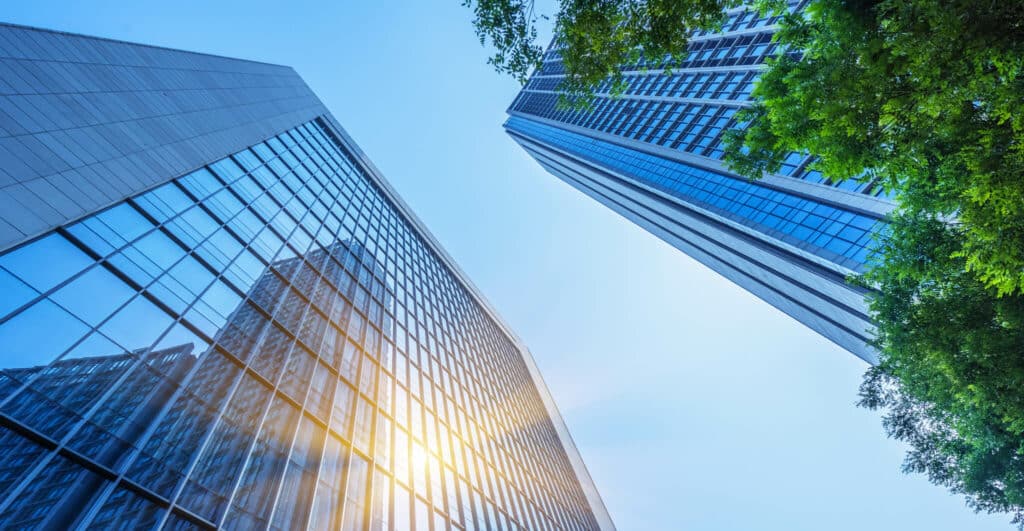In the real estate industry, a lot of weight is placed on LEED certification. But many property owners aren’t familiar with the exact definition of “LEED certified.” This guide covers LEED certification and its many benefits. LEED (Leadership in Energy & Environmental Design) is an internationally recognized green building certification system sponsored by the U.S. Green Building Council (USGBC).
How does it work?
LEED certification is awarded to buildings that meet certain sustainable design, construction, and operational criteria.
LEED certification is a voluntary program that provides independent verification of a building’s environmental performance. The certification process evaluates a building’s energy and water efficiency, materials selection, indoor environmental quality, and other sustainable practices. It also takes into account the location and transportation options available to the building’s occupants.
LEED certification is available for a range of building types, including commercial buildings, residential buildings, schools, healthcare facilities, and more. The rating system offers four levels of certification: Certified, Silver, Gold, and Platinum. Buildings must earn a certain number of points on a 100-point scale to achieve certification at each level.
LEED certification is widely recognized as a mark of quality and sustainability in the building industry. It can help building owners and developers reduce operating costs, improve the health and well-being of occupants, and enhance the overall environmental performance of their buildings.
What are the different levels?
The different levels of certification that a building can achieve under the LEED (Leadership in Energy and Environmental Design) rating system are:
- Certified: This is the entry-level certification, and buildings must earn between 40 and 49 points on the 100-point scale to achieve it.
- Silver: Buildings must earn between 50 and 59 points on the 100-point scale to achieve the Silver level of certification.
- Gold: Buildings must earn between 60 and 79 points on the 100-point scale to achieve the Gold level of certification.
- Platinum: This is the highest level of LEED certification, and buildings must earn 80 or more points on the 100-point scale to achieve it.
The LEED certification levels are intended to provide recognition and motivation for building owners and developers to pursue increasingly sustainable and environmentally friendly design, construction, and operation practices. The levels help to communicate to stakeholders the degree to which a building has met the LEED criteria, with higher levels indicating more comprehensive and significant environmental performance.
How to obtain LEED certification?
To obtain LEED certification for a building, you must follow the Leadership in Energy and Environmental Design (LEED) rating system developed by the U.S. Green Building Council (USGBC). Here are the general steps to obtain LEED certification:
- Determine your building’s eligibility: LEED certification is available for new and existing buildings, as well as for interior spaces and neighborhoods. Determine which type of certification is appropriate for your building project.
- Register your project: Register your project on the USGBC website and pay the registration fee. This will give you access to the LEED Online platform, where you will submit documentation and track progress throughout the certification process.
- Select a LEED rating system: Choose the LEED rating system that is most appropriate for your building project. There are several rating systems available, including LEED for Building Design and Construction (BD+C), LEED for Interior Design and Construction (ID+C), and LEED for Operations and Maintenance (O+M).
- Develop a sustainable design strategy: Develop a sustainable design strategy that meets the requirements of the chosen LEED rating system. The strategy should address energy efficiency, water conservation, indoor air quality, materials selection, and other sustainability factors.
- Submit documentation: Submit documentation through the LEED Online platform to demonstrate that your building project meets the requirements of the chosen LEED rating system. Documentation may include design plans, energy models, construction specifications, and product data sheets.
- Schedule and complete reviews: Schedule and complete reviews with a LEED-accredited professional or a Green Business Certification Inc. (GBCI) reviewer to verify that your project meets the requirements of the chosen LEED rating system.
- Achieve certification: Once your project has been reviewed and meets the requirements of the chosen LEED rating system, you will receive a LEED certification plaque and be recognized on the USGBC website.
The LEED certification process can be complex and time-consuming, so it is recommended to work with a LEED-accredited professional who can guide you through the process and help ensure that your project meets the necessary requirements.
